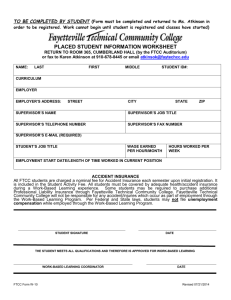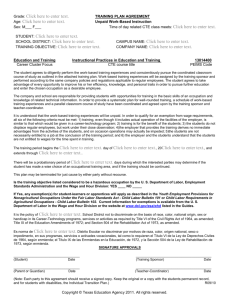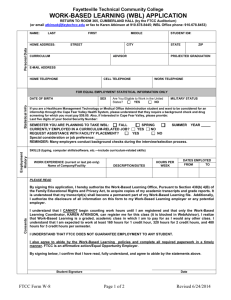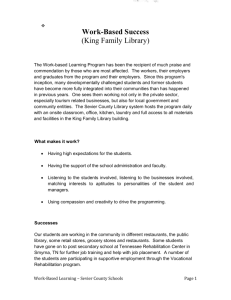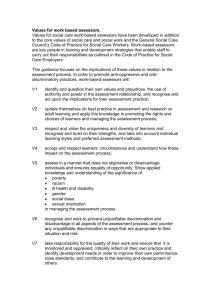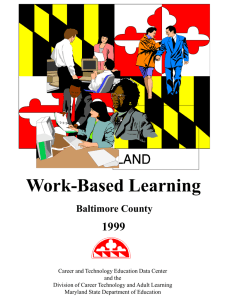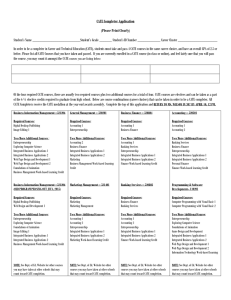Work-based learning
advertisement
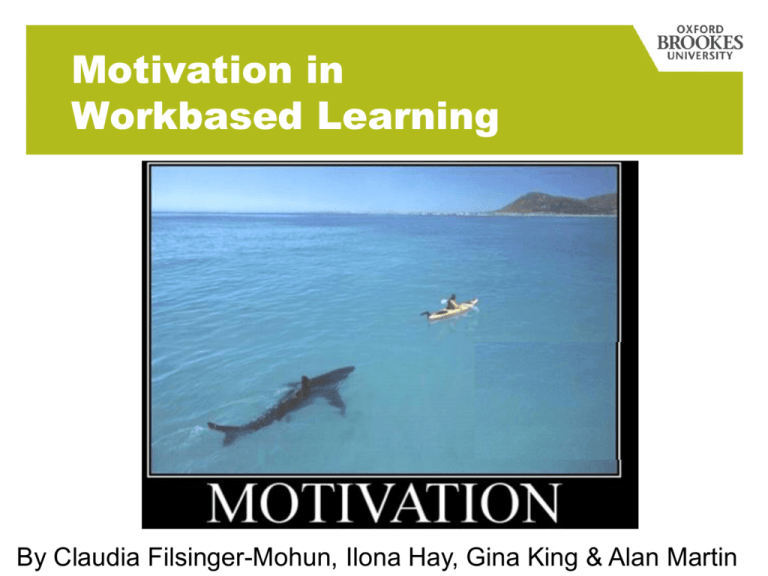
Motivation in Workbased Learning By Claudia Filsinger-Mohun, Ilona Hay, Gina King & Alan Martin Learning Outcome Evaluate student motivation factors for work-based learning Work-based learning context How learning takes place Higher Education Employment/Work Learning THROUGH/AT work (Certificates, degrees etc and short courses while employed) Learning FOR work (placements, short internships and course related projects) while in HE Widening Participation (Thomas, 2001) Employability (Lemanski et al., 2011) Work-based learning context Stakeholders students (HEFCE, 2011; EURO RSCG HEIST, 2011) employers university professional bodies Barriers and Enablers to motivation On each table there are 2 named cards that expresses a form of work based learning, choose one that most applies to the subject you teach. Find a partner who has chosen the same card. For 2 minutes discuss and name one barrier and one enabler that affect motivation in work based learning. Motivation theories • Expectancy-Value theory (Wigfield & Eccles, 2000) Expectation of success and value of the task • Interest theory (Hidi & Renninger, 2006) Desire to engage over time • Achievement goal theory (Harackiewicz & Elliot, 1993) Performance or Mastery approaches to motivation Motivational factors (Helle et al. 2007) • Authenticity Expectancy-value theory Does the learning match the real world experience • Competence Interest theory Opportunities to succeed at work based skills • Autonomy Achievement goal theory The extent to which the learning is teacher driven or student driven Brainstorming additional factors In your groups think of three additional factors that might have an effect upon student motivation in a work based learning course Think of factors that contrast with the three outlined above On your table there are 6 “bricks”, write the name of each of your group’s factors on each of the 3 (blank) “bricks” Prioritising motivation factors In each of your groups create a tower in order of priority for the group so that the highest “brick” represents the top priority factor to consider. You can be creative! Summary 1. What is the student context (work based or Higher Education based)? 2. Which motivational factors are most important when making design decisions for Work-Based Learning courses? 3. What is the influence of external stakeholders (e.g. employers, professional bodies)? Feedback STOP START CONTINUE Thank you for listening Any Questions? Further information on Work-based Learning • Brookes University: http://www.brookes.ac.uk/business-andemployers/workforce-development/ • Middlesex University Resources http://www.mdx.ac.uk/research/iwbl/public ations/index.aspx References/Bibliography Boud, D. and Solomon, N., 2001. Work-based Learning - A New Higher Education? Buckingham: SRHE and Open University Press. Clarke, J. and Copeland, L., 2003. ‘Developing nursing practice through work-based learning’. Nurse Education in Practice, Vol. 3, Issue4, pp. 236-244. Edwards, K., 2013. ‘Moments of Possibility: An Exploration of Adult Participation in Work-based Learning’. Widening Participation and Lifelong Learning, Winter, 15 (4), pp.65-80. EURO RSCG HEIST, 2011. HIs, CPD and Employer Engagement. [online] Available at: http://www.brookes.ac.uk/business-and employers/workforce-developmenthttp://www.brookes.ac.uk/business-and-employers/workforce-development [accessed 3 March 2014] HEFCE, 2011. Evaluation of the Higher Education Transforming Workforce Development Programme. [online] Available at: https://www.hefce.ac.uk/media/hefce/content/pubs/indirreports/2011/re1311workforcedevprog/rd13_11.pdf (accessed 3rd March 2011) Helle, L., Tynjala, P., Olkinuora, E. and Lonka, K., 2007. “Ain't nothin' like the real thing'. Motivation and study processes on a work-based project course in information systems design.” British Journal of Educational Psychology 77, pp.397-411. Helyer, R., 2010. The Work-based Learning Student Handbook. Basingstoke: Palgrave Macmillan Keeling, D., Jones, E., Botterill, D. and Gray, C. ‘Work Based Learning: Motivation and Employer and Employee interaction: implications for lifelong learning’. IETI, 35 (4), pp.282-291. Lemanski, T., Mevis, R., and Overton, T., 2011. ‘An Introduction to Workbased Learning’. New Directions in the teaching of Physical Sciences, Issue 6, September, pp.3-10. Marriot, N., Telford, B., Davies, M. and Evans, J., 2011. ‘Students’ Perceptions of Work-Based Training and Examination-Based Learning Relating to the Professional Competence of Auditors and the Impact of Regulatory Changes on Audit Training in the UK’. Accounting Education: an international journal, April, 20 (2), pp.133–151. Maureen, K., Walsh-Blair, L., 2010. ‘Achievement motivation among urban adolescents: Work hope, autonomy support, and achievementrelated beliefs’. Journal of Vocational Behavior, Oct, 77(2), pp.205-212. Mumford, J. and Roodhouse, S., 2010. Understanding Work-based Learning. Farnham: Gower. Raelin, J., 2008. Workbased Learning. San Francisco: Jossey Bass. Thomas, L., 2001, Widening Participation in Post-Compulsary Education. London: Continuum. Waskiewicz, R., 2012. ‘Achievement Goal Orientation and Situational Motivation for a Low-Stakes Test of Content Knowledge’. American Journal of Pharmaceutical Education, 76 (4) Article 65, pp. 1-6. E
